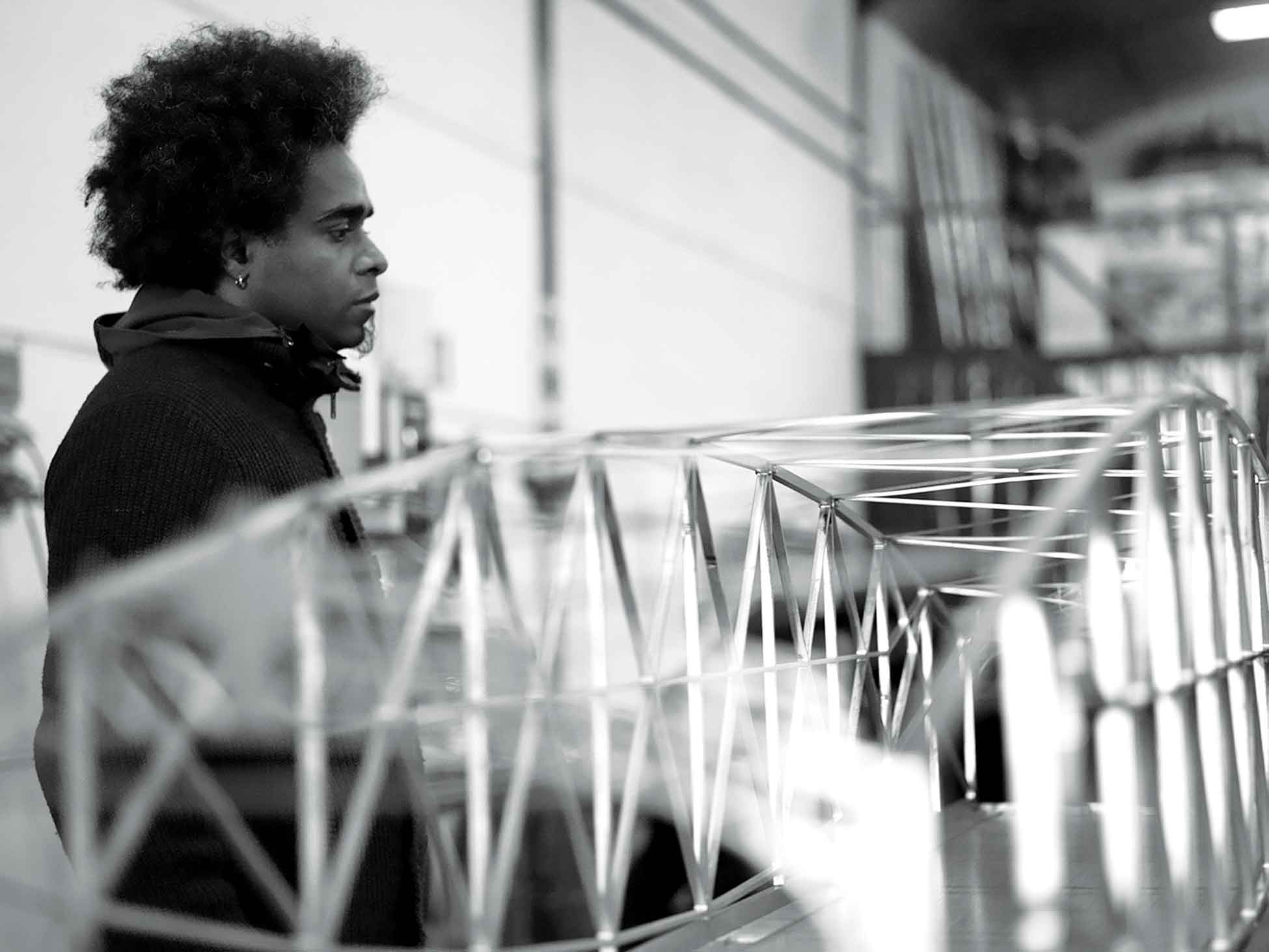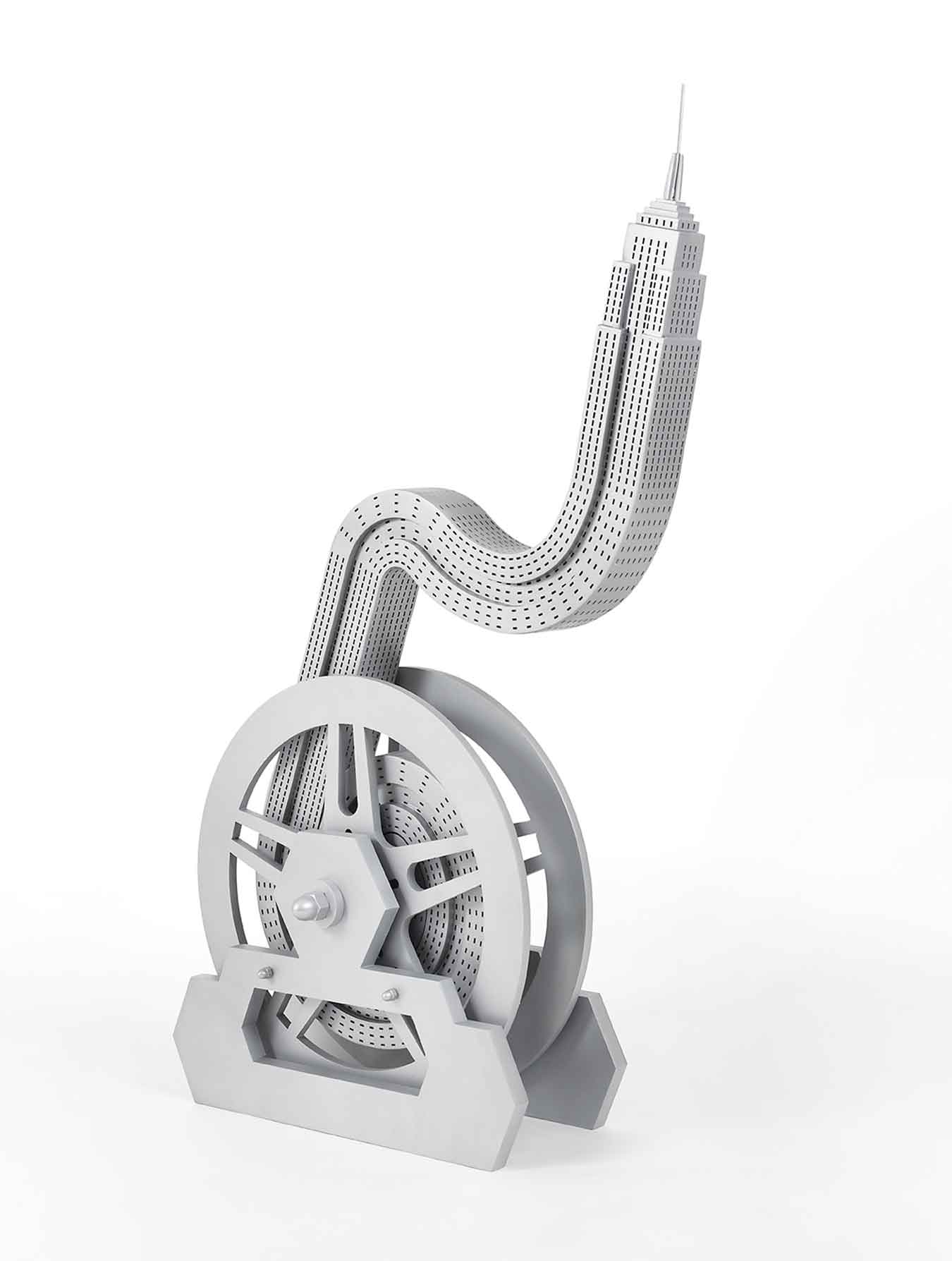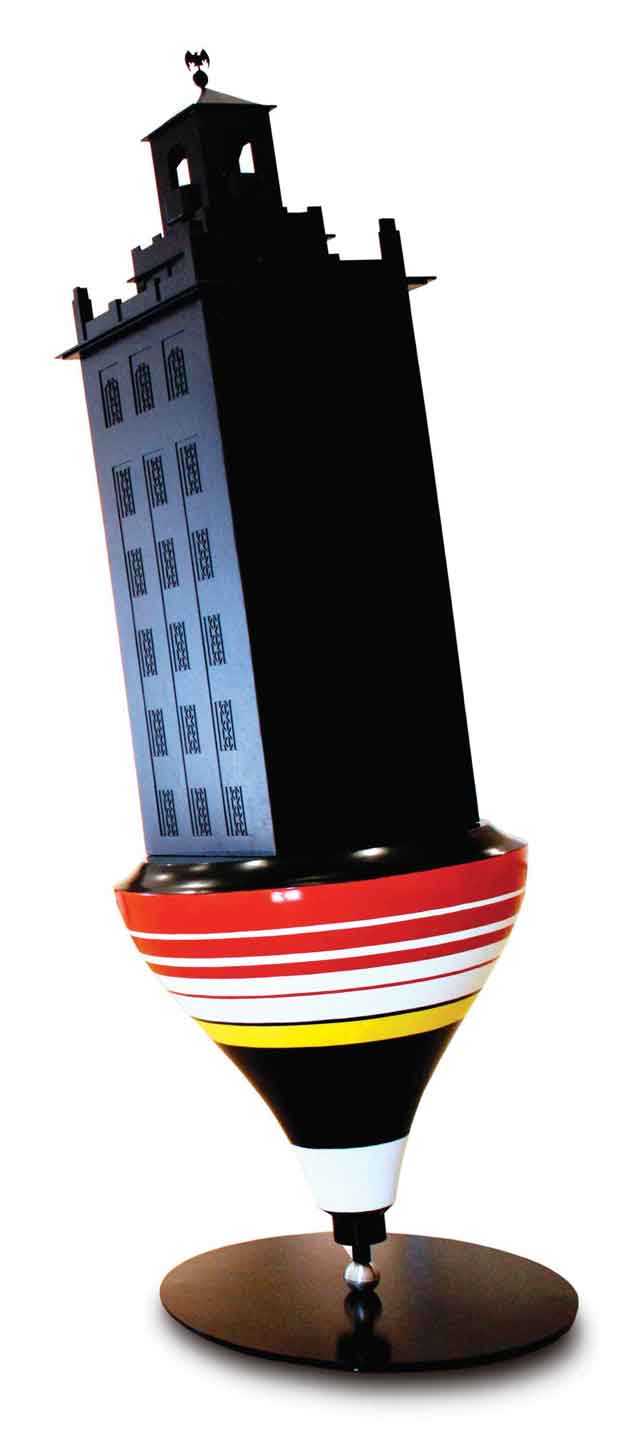« Features
Unfreezing a World in Perpetual Motion. An Interview with Alexandre Arrechea
Cuban-born artist Alexandre Arrechea makes beautifully crafted, deceptively whimsical works about the power that our social settings and communal practices have in shaping personal identity and collective experience. Over the last few years, his career has taken him around the world, where he has exhibited works for which context is often as important as medium; his pieces have ranged from delicate watercolors and graphite drawings to massive sculptural installations and outdoor video projections. Arrechea’s latest project (to be unveiled in March 2013) will feature fancifully distorted monolithic replicas of landmark buildings placed in the traffic islands running down the middle of Park Avenue in New York City. In this interview, we spoke with Arrechea about the Park Avenue Project and its relationship to his previous art, the challenges of working internationally, and some of the themes that underlie his entire body of work.
By Jeff Edwards

Alexandre Arrechea in his studio. Photo: Rafael García Sánchez.All images are courtesy of the artist and Magnan Metz Gallery.
Jeff Edwards - A lot of your art explores the relationship between public and private space and the way in which the former can intrude into the latter. Surveillance has also played a significant role in works such as The Garden of Mistrust (2003) and Perpetual Free Entrance (2006), both of which included camera systems directed at visitors to the exhibitions where they were displayed. What led you to bring your audiences into these works in this way, and are similar ideas at work in your upcoming Park Avenue Project?
Alexandre Arrechea - I think stepping out of the collaborative experience that was my initial work and moving on as a solo artist carried a decisive weight when I realized I was determined to explore the relationships between collective experiences versus the individual within society. I was also interested in comparing public and private spaces; to investigate the potential tensions between these two worlds from different angles. So, all in all, this was all a very organic process. The growing phenomenon that is surveillance in society, which is considered ‘normal,’ also inspired me in my early work to discuss the anxiety we feel as we lose privacy under systematic supervision. The Garden of Mistrust, in particular, clearly exhibits this notion of surveillance and control. At the same time, my intentions with this work are to show the result of control on the adjacent walls and ceiling that surround the sculpture. Large projections of live footage, recorded by the cameras installed in the ‘tree,’ can be observed as you walk through the installation. This, in turn, dismantles the pretentious apparatus.
On the other hand, Perpetual Free Entrance, exhibited at the Patio Herreriano Museum in Valladolid, Spain, plays with the relationship between the visitor and their accessibility to the museum and the artwork inside. I decided to record the regulated entry of the visitors and later display it in a video loop on a large, flat-screen TV at the entrances of an organic wooden stadium. This gave viewers the sensation of no regulation in their access to the artwork. The discussion of public and private spaces is something I have addressed in many different degrees. I think that Park Avenue will bring a new perspective to my work where these initial games of power now contemplate the possible lack of control. I will be transforming iconic architectural landmarks into a shifting landscape.
J.E. - For several years you were refused entry into the United States under the Homeland Security Act and were unable to see some of your own works on exhibit here. Has being a Cuban artist on the international scene caused similar complications elsewhere, and how has this affected your art?
A.A. - Yes, you’re right. Between 2003 and 2008, like many other Cuban artists, I was refused entry to the U.S. because of the post-9/11 policies. This forced me to change my strategies in regards to how I was going to exhibit my work. A few of us in Cuba started to look towards Europe. We traveled and eventually settled there. Not being able to travel to the U.S. forced me to now put my trust in fabricators there that I had never met. It was necessary for me to accept building my work from a distance in order to continue my artistic dialogue with New York and Los Angeles. I traveled to New York for the first time in 1996 to exhibit my work-it’s where my dialogue with the States really began. It continued steadily until 2003. I then began to work more closely with Magnan Metz Gallery (N.Y.) and my fabricators via email, sending them detailed drawings of my installations, the materials I wanted to use, the layout of the installations in galleries and museums, etc. All of this work I would see exhibited maybe four to five years after they had initially been installed. It was a strange feeling. This very limited practice of working from a distance turned out to be a regular procedure in my work that persists today. It has become somewhat convenient even though traveling conditions have substantially changed for me.
J.E. - In 2009 you did another public project in New York: the video Black Sun, which projected a swinging trompe l’oeil wrecking ball onto the surface of the NASDAQ corner billboard in Times Square. How are the logistics different for the upcoming project, and did your experience with Black Sun make it easier to stage this one?
A.A. - Black Sun follows a previous, and very important, public art project I participated in New Orleans. There I exhibited Mississippi Bucket at Prospect.1 with Dan Cameron. It was a large wooden bucket in the shape of the Mississippi River. It was linked to the disaster that had occurred after Hurricane Katrina. The logistic work with this project was complex, but in the end it was a very positive experience that helped me to follow with Black Sun the next year. I think Black Sun owes a lot to Mississippi Bucket. These works are directly connected if you consider the human and economic crises that serve as the backdrop in both. The international economic context within Black Sun, specifically when it was exhibited in Times Square, was relevant during the peak of the crisis. Exhibiting this video of a wrecking ball swinging on the NASDAQ screen was really my first opportunity to establish a public dialogue with New York. The fact that Times Square is a place visited by people from all over the world made my message global. After this video was shown, people started to look at my work differently. Black Sun definitely paved the way to Park Avenue. The logistics are far more complicated now, but I have gained great experience working with other outdoor projects.

The Dream of Shreve, Lamb and Harmon, 2011, (Empire state Building), aluminum, 25” x 6” x 39”. Private collection.
J.E. - How does a big public commission like the Park Avenue Project relate to your smaller, gallery-based works? Do you conceive of the two halves of your body of work as separate from each other or as variations on a single theme?
A.A. - One aspect that determines my practice is to understand the context of where the work is to be shown. This plays a major role in my decision rather than the scale of the work being big or small. Park Avenue only confirms the modus operandi in my practice-the dialogue I want to establish between the work and the context of its exhibition. With Park Avenue, I plan to extend my concerns on issues such as power, control, shifting architecture, etc., to a broader audience.
J.E. - The Park Avenue Project seems to be closely related to an earlier series of sculptures in which you transformed famous skyscrapers into massive toy tops tipped onto their sides. I‘ve seen those pieces described as being both utopian and cynical because of the way they convert dignified modernist/capitalist icons into playful but stubbornly inert and unbalanced objects. Is there a similar ambiguity at work in the pieces you‘ll be exhibiting on Park Avenue?
A.A. - You are referring to the series, The City That Stopped Dancing, and yes, it does relate to themes found in Park Avenue. I actually conceived Park Avenue as a sort of conclusion to the last three years of my work, where utopia and failure have been the common subjects. One thing that attracted me to Park Avenue though, as opposed to these previous scenarios, is that it is not related to failure. Success is actually what defines this portion of Manhattan, so something that makes this project unique is that most of the buildings I have chosen to work with are from the Park Avenue area. They are to be the actors in a sort of carnival-esque representation. Another important aspect of this project is to exhibit my personal views on public art-what I believe are the social obligations of public art. This is an opportunity for me to establish a dialogue with the space where the project is generated, as well as with the community it is addressing. I hope this dialogue will touch upon both the aspirations and the frustrations of the people. I look at public art as a tool that helps reveal the determinations of a community or city.
Through Park Avenue, I am constructing new realities based on preexisting architecture that will ‘intersect and negotiate’ with other architectural elements as well as aspects of the human condition. I believe that a building is ‘exposed’ to many things other than the obvious cold, heat, rain, fog, snow, etc. It also constantly endures changes in its functions, increases/decreases in market value, social transformations. This persistent change of exposure to many different factors is something I want to capture and translate into my work-creating a new model that is in constant negotiation with its surroundings.

Bacardi, 2010. From “The City that Stopped Dancing” series, aluminum, wood, resin, 156” x 43”, diameter.
J.E. - A lot of your work in various mediums shows an incredible amount of attention craftsmanship, including painstakingly precise rendering in your drawings and tiny bits of realistic detail in your architectural sculptures. Does this precision and care have any conceptual value in your art?
A.A. - The Park Avenue Project, beyond the meaning and metaphors, is also a tribute to the work, collaboration and trust that is put into it. The people involved in helping to fabricate my work are highly professional individuals-starting from my CAD designer in Havana, Lizbet, my gallery, Magnan Metz, and the group of artisan welders and artists that are helping to make this possible in New York and Madrid. My interest in well-crafted objects is something that, in one way or another, has been a constant in my work since the early 1990s, when I dedicated, along with my collaborator Dagoberto Rodriguez in the early stage of Los Carpinteros, a show for the cigar laborers at the Partagas factory in Havana. At that time, my interest was in a more naïve art object charged with history and the exquisite craft we took from the industry in Cuba. With Park Avenue, there is a similar approach. I am presenting ‘problematic objects’ to this city. I hope to translate all the richness of the architecture in New York, and I don’t want to miss a single detail in order to make New Yorkers engage the landmarks they regularly inhabit. For me, the craft is as essential as the meaning.
J.E. - Has making much larger works for outdoor display created new demands or problems in terms of the way that craftsmanship functions in them?
A.A. - No, it basically works the same way.
J.E. - What‘s next after the Park Avenue Project? Do you have any other big projects in the works?
A.A. - Well, at the moment I am planning my second show in Paris and a solo exhibition at the Casado Santapau Gallery in Spain. Magnan Metz Gallery is also working on various offers of other solo museum shows as well as a follow-up show at the gallery. All of this combined is a new and big challenge for me, and I’m very excited.
Jeff Edwards is an arts writer and faculty member in the Visual and Critical Studies program at the School of Visual Arts (SVA) in New York. He has a Master of Fine Arts in art criticism and writing from SVA and a master’s degree in public and private management from the Yale School of Management.






































Leave a Reply
You must be logged in to post a comment.